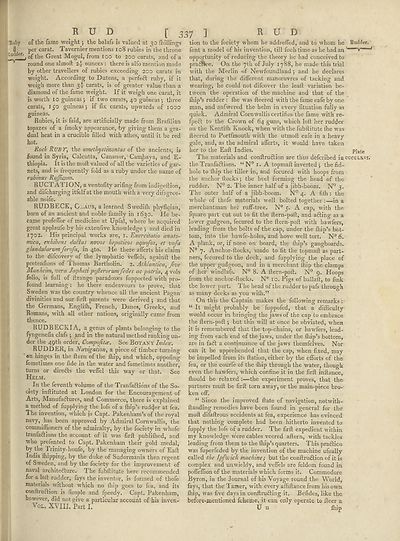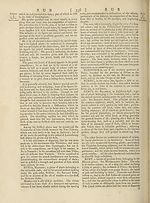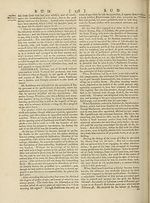Encyclopaedia Britannica, or, a Dictionary of arts, sciences, and miscellaneous literature : enlarged and improved. Illustrated with nearly six hundred engravings > Volume 18, RHI-SCR
(353) Page 337
Download files
Complete book:
Individual page:
Thumbnail gallery: Grid view | List view

R U D [ 337 ] R u D
:Ruby of the fame weight j the balafs is valued at 30 {hillings
ti per carat. Tavernier mentions 108 rubies in the throne
'LtHltter.^ Qf j.jjg Great Mogul, from loo to 200 carats, and of a
round one almoft 2? ounces : there is alfo mention made
by other travellers of rubies exceeding 200 carats in
weight. According to Dutens, a perfect ruby, if it
weigh more than 34 carats, is of greater value than a
diamond of the fame weight. If it weigh one carat, it
is worth 10 guineas j if two carats, 40 guineas; three
carats, 150 guineas j if fix carats, upwards of 1000
guineas.
Rubies, it is faid, are artificially made from Brafilian
topazes of a fmoky appearance, by giving them a gra¬
dual heat in a crucible filled with aihes, until it be red
hot.
Rod: RUBT, the amethystixontus of the ancients, is
found in Syria, Calcutta, Cananor, Cambaya, and E-
thiopia. It is the moft valued of all the varieties of gar¬
nets, and is frequently fold as a ruby under the name of
rubinus RuJJiaim.
RUCTATION, a ventofity arifing from indigeftion,
and difcharging itfelfat the mouth with a very difagree-
able noife.
RUDBECK, G—aus, a learned Swedifh phyfician,
born of an ancient and noble family in 1630. He be¬
came profeffor of medicine at Upfal, where he acquired
great applaufe by his extenfive knowledge ; and died in
1702. His principal w'orks are, 1. Exercitatio anato-
mica, cxhibens ducius novos hepaticos aquofos, et vafa
glandularum ferofa, in qto. He there afferts his claim
to the difcovery of the lymphatic Veffels, againft the
pretenfions of Thomas Bartholin. 2. Athlantica, five
Munheim, vera Japhetipoferorumfedes ac patria, 4 vols
folio, is full of ftrange paradoxes fupported with pro¬
found learning : he there endeavours to prove, that
Sweden was the country whence all the ancient Pagan
divinities and our firft parents were derived j and that
the Germans, Englilh, French, Danes, Greeks, and
Romans, with all other nations, originally came from
thence.
RUDBECKIA, a genus of plants belonging to the
fyngenefia clafs ; and in the natural method ranking un¬
der the 49th order, Compojitce. See Botany Index.
RUDDER, in Navigation, a piece of timber turning
on hinges in the ftern of the fhip, and which, oppofing
fometimes one fide in the water and fometimes another,
turns or diredls the veffel this way or that. See
Helm.
. In the feventh volume of the Tranfa&idns of the So¬
ciety inftituted at London for the Encouragement of
Arts, Manufailures, and Commerce, there is explained
a method of fupplying the lofs of a {hip’s rudtjer at fea.
The invention, which is Capt. Pakenham’s of the royal
navy, has been approved by Admiral Cornwallis, the
commiffioners of the admiralty, by the fociety in whofe
tranfa&ions the account of it was firfl: publilhed, and
who prefented to Capt. Pakenham their gold medal,
by the I rinity-houfe, by the managing owners of Eaft
India {hipping, by the duke of Sudermania then regent
of Sweden, and by the fociety for the improvement of
naval architedture. The fubflitute here recommended
for a loft rudder, fays the inventor, is formed of thofe
materials without which no {hip goes to fea, and its
conftrudtion is ample and ipeedy. Capt. Pakenham,
however, did not give a particular account of his inven-
Vol. XVIII, Part I.
tion to the fociety whom he addreffed, and to whom he Rudder,
fent a model of his invention, till fuch time as he had an
opportunity of reducing the theory he had conceived to
pradBce. On the 7th of July 1788, he made this trial
with the Merlin of Newfoundland; and he declares
that, during the different manoeuvres of tacking and
wearing, he could not difcover the leaft variation be¬
tween the operation of the machine and that of the
{hip’s rudder : the was fteered with the fame eafe by one
man, and anfwered the helm in every fituation fully as
quick. Admiral Cornwallis certifies the fame with re-
fpedl to the Crown of 64 guns, which loft her rudder
on the Kentilh Knock, when with the fubftitute ihe was
fteered to Portfmouth with the utmoft eafe in a heavy
gale, and, as the admiral aflerts, it would have taken
her to the Eaft Indies. Plate
The materials and conftrudlion are thus defcribed inccccLxvi.
the Tranfadlions. “ N° 1. A topmaft inverted j the fid-
hole to fhip the tiller in, and fecured with hoops from
the anchor flocks; the heel forming the head of the
rudder. N° 2. The inner half of a jibb-boom. N° 3.
The outer half of a jibb-boom. N° 4. A fifti: the
whole of thefe materials well bolted together :—in a
merchantman her ruff-tree. N° 5. A cap, with the
fquare part cut out to fit the ftern-poft, and adling as a
lower gudgeon, fecured to the ftern-poft with hawfers,
leading from the bolts of the cap, under the {hip’s bot¬
tom, into the hawfe-holes, and hove well tort. N° 6.
A plank, or, if none on board, the fhip’s gangboards.
N° 7. Anchor-ftocks, made to fit the topmaft as part¬
ners, fecured to the deck, and fupplying the place of
the upper gudgeon, and in a merchant {hip the clamps
of her windlafs. N° 8. A ftern-poft. N° 9. Hoops
from the anchor-ftocks. N° 10. Pigs of ballaft, to fink
the lower part. The head of the rudder to pafs through
as many decks as you with.”
On this the Captain makes the following remarks :
“ It might probably be fuppofed, that a difficulty
Avould occur in bringing the jaws of the cap to embrace
the ftern-poft j but this will at once be obviated, when
it is remembered that the top-chains, or hawfers, lead¬
ing from each end of the jaws, under the ftiip’s bottom,
are in fa£l a continuance of the jaws themfelves. Nor
can it be apprehended that the cap, when fixed, may
be impelled from its ftation, either by the efforts of the
fea, or the courfe of the (hip through the water, though
even the hawfers, which confine it in the firft inftance,
ftiould be relaxed :—the experiment proves, that the
partners muft be firft torn away, or the main-piece bro¬
ken off.
“ Since the improved ftate of navigation, notwith-
ftanding remedies have been found in general for the
moft difaftrous accidents at fea, experience has evinced
that nothing complete had been hitherto invented to
fupply the lofs of a rudder. The firft expedient within
my knowledge were cables veered aftern, with tackles
leading from them to the {hip’s quarters. This practice
was fuperfeded by the invention of the machine ufually
called the Ipfvuich machine; but the conftrudtion of it is
complex and unwieldy, and veffels are feldom found in
poffeflion of the materials which forms it. Commodore
Byron, in the Journal of his Voyage round the World,
fays, that the Tamer, with every afliftance from his own
{hip, was five days in conftrudting it. Befides, like the
before-mentioned fcheme, it can only operate to fleer a
U u fhip
:Ruby of the fame weight j the balafs is valued at 30 {hillings
ti per carat. Tavernier mentions 108 rubies in the throne
'LtHltter.^ Qf j.jjg Great Mogul, from loo to 200 carats, and of a
round one almoft 2? ounces : there is alfo mention made
by other travellers of rubies exceeding 200 carats in
weight. According to Dutens, a perfect ruby, if it
weigh more than 34 carats, is of greater value than a
diamond of the fame weight. If it weigh one carat, it
is worth 10 guineas j if two carats, 40 guineas; three
carats, 150 guineas j if fix carats, upwards of 1000
guineas.
Rubies, it is faid, are artificially made from Brafilian
topazes of a fmoky appearance, by giving them a gra¬
dual heat in a crucible filled with aihes, until it be red
hot.
Rod: RUBT, the amethystixontus of the ancients, is
found in Syria, Calcutta, Cananor, Cambaya, and E-
thiopia. It is the moft valued of all the varieties of gar¬
nets, and is frequently fold as a ruby under the name of
rubinus RuJJiaim.
RUCTATION, a ventofity arifing from indigeftion,
and difcharging itfelfat the mouth with a very difagree-
able noife.
RUDBECK, G—aus, a learned Swedifh phyfician,
born of an ancient and noble family in 1630. He be¬
came profeffor of medicine at Upfal, where he acquired
great applaufe by his extenfive knowledge ; and died in
1702. His principal w'orks are, 1. Exercitatio anato-
mica, cxhibens ducius novos hepaticos aquofos, et vafa
glandularum ferofa, in qto. He there afferts his claim
to the difcovery of the lymphatic Veffels, againft the
pretenfions of Thomas Bartholin. 2. Athlantica, five
Munheim, vera Japhetipoferorumfedes ac patria, 4 vols
folio, is full of ftrange paradoxes fupported with pro¬
found learning : he there endeavours to prove, that
Sweden was the country whence all the ancient Pagan
divinities and our firft parents were derived j and that
the Germans, Englilh, French, Danes, Greeks, and
Romans, with all other nations, originally came from
thence.
RUDBECKIA, a genus of plants belonging to the
fyngenefia clafs ; and in the natural method ranking un¬
der the 49th order, Compojitce. See Botany Index.
RUDDER, in Navigation, a piece of timber turning
on hinges in the ftern of the fhip, and which, oppofing
fometimes one fide in the water and fometimes another,
turns or diredls the veffel this way or that. See
Helm.
. In the feventh volume of the Tranfa&idns of the So¬
ciety inftituted at London for the Encouragement of
Arts, Manufailures, and Commerce, there is explained
a method of fupplying the lofs of a {hip’s rudtjer at fea.
The invention, which is Capt. Pakenham’s of the royal
navy, has been approved by Admiral Cornwallis, the
commiffioners of the admiralty, by the fociety in whofe
tranfa&ions the account of it was firfl: publilhed, and
who prefented to Capt. Pakenham their gold medal,
by the I rinity-houfe, by the managing owners of Eaft
India {hipping, by the duke of Sudermania then regent
of Sweden, and by the fociety for the improvement of
naval architedture. The fubflitute here recommended
for a loft rudder, fays the inventor, is formed of thofe
materials without which no {hip goes to fea, and its
conftrudtion is ample and ipeedy. Capt. Pakenham,
however, did not give a particular account of his inven-
Vol. XVIII, Part I.
tion to the fociety whom he addreffed, and to whom he Rudder,
fent a model of his invention, till fuch time as he had an
opportunity of reducing the theory he had conceived to
pradBce. On the 7th of July 1788, he made this trial
with the Merlin of Newfoundland; and he declares
that, during the different manoeuvres of tacking and
wearing, he could not difcover the leaft variation be¬
tween the operation of the machine and that of the
{hip’s rudder : the was fteered with the fame eafe by one
man, and anfwered the helm in every fituation fully as
quick. Admiral Cornwallis certifies the fame with re-
fpedl to the Crown of 64 guns, which loft her rudder
on the Kentilh Knock, when with the fubftitute ihe was
fteered to Portfmouth with the utmoft eafe in a heavy
gale, and, as the admiral aflerts, it would have taken
her to the Eaft Indies. Plate
The materials and conftrudlion are thus defcribed inccccLxvi.
the Tranfadlions. “ N° 1. A topmaft inverted j the fid-
hole to fhip the tiller in, and fecured with hoops from
the anchor flocks; the heel forming the head of the
rudder. N° 2. The inner half of a jibb-boom. N° 3.
The outer half of a jibb-boom. N° 4. A fifti: the
whole of thefe materials well bolted together :—in a
merchantman her ruff-tree. N° 5. A cap, with the
fquare part cut out to fit the ftern-poft, and adling as a
lower gudgeon, fecured to the ftern-poft with hawfers,
leading from the bolts of the cap, under the {hip’s bot¬
tom, into the hawfe-holes, and hove well tort. N° 6.
A plank, or, if none on board, the fhip’s gangboards.
N° 7. Anchor-ftocks, made to fit the topmaft as part¬
ners, fecured to the deck, and fupplying the place of
the upper gudgeon, and in a merchant {hip the clamps
of her windlafs. N° 8. A ftern-poft. N° 9. Hoops
from the anchor-ftocks. N° 10. Pigs of ballaft, to fink
the lower part. The head of the rudder to pafs through
as many decks as you with.”
On this the Captain makes the following remarks :
“ It might probably be fuppofed, that a difficulty
Avould occur in bringing the jaws of the cap to embrace
the ftern-poft j but this will at once be obviated, when
it is remembered that the top-chains, or hawfers, lead¬
ing from each end of the jaws, under the ftiip’s bottom,
are in fa£l a continuance of the jaws themfelves. Nor
can it be apprehended that the cap, when fixed, may
be impelled from its ftation, either by the efforts of the
fea, or the courfe of the (hip through the water, though
even the hawfers, which confine it in the firft inftance,
ftiould be relaxed :—the experiment proves, that the
partners muft be firft torn away, or the main-piece bro¬
ken off.
“ Since the improved ftate of navigation, notwith-
ftanding remedies have been found in general for the
moft difaftrous accidents at fea, experience has evinced
that nothing complete had been hitherto invented to
fupply the lofs of a rudder. The firft expedient within
my knowledge were cables veered aftern, with tackles
leading from them to the {hip’s quarters. This practice
was fuperfeded by the invention of the machine ufually
called the Ipfvuich machine; but the conftrudtion of it is
complex and unwieldy, and veffels are feldom found in
poffeflion of the materials which forms it. Commodore
Byron, in the Journal of his Voyage round the World,
fays, that the Tamer, with every afliftance from his own
{hip, was five days in conftrudting it. Befides, like the
before-mentioned fcheme, it can only operate to fleer a
U u fhip
Set display mode to:
![]() Universal Viewer |
Universal Viewer | ![]() Mirador |
Large image | Transcription
Mirador |
Large image | Transcription
Images and transcriptions on this page, including medium image downloads, may be used under the Creative Commons Attribution 4.0 International Licence unless otherwise stated. ![]()
| Permanent URL | https://digital.nls.uk/193023296 |
|---|
| Attribution and copyright: |
|
|---|
| Description | Ten editions of 'Encyclopaedia Britannica', issued from 1768-1903, in 231 volumes. Originally issued in 100 weekly parts (3 volumes) between 1768 and 1771 by publishers: Colin Macfarquhar and Andrew Bell (Edinburgh); editor: William Smellie: engraver: Andrew Bell. Expanded editions in the 19th century featured more volumes and contributions from leading experts in their fields. Managed and published in Edinburgh up to the 9th edition (25 volumes, from 1875-1889); the 10th edition (1902-1903) re-issued the 9th edition, with 11 supplementary volumes. |
|---|---|
| Additional NLS resources: |
|

